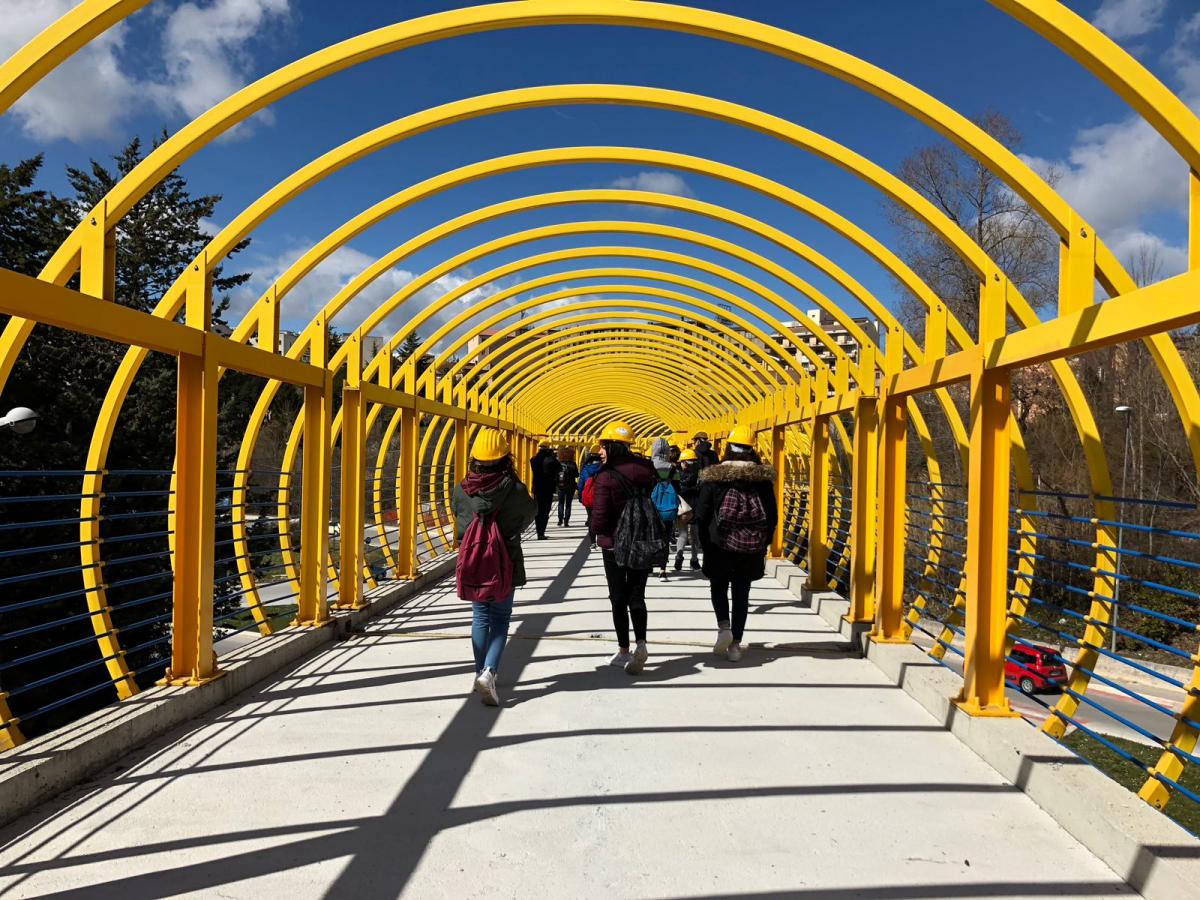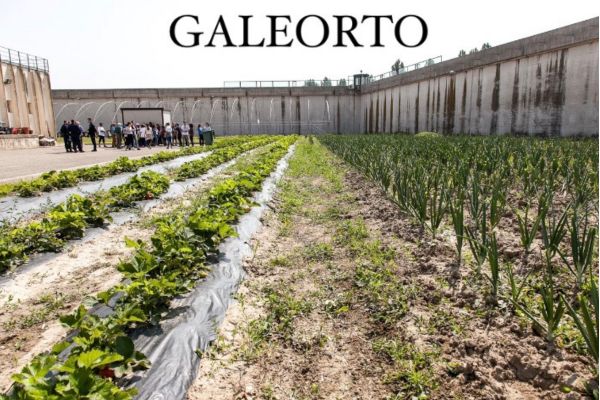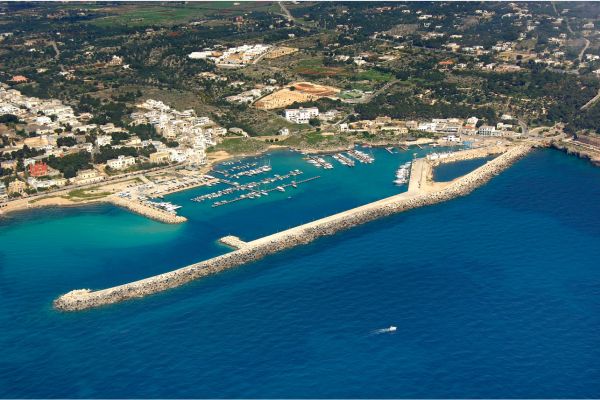Walking People on the move for the walkway at the Campobasso bus terminal
All who use the pedestrian walkway connecting the Campobasso bus terminal to the city centre can’t help but notice the ubiquitous logo posted on the signage.
It is the logo of the team Walking People of the Giuseppe Maria Galanti Economics Secondary School, which, for the 2017-2018 edition of the project A Scuola di OpenCoesione (ASOC), monitored the project to complete the pedestrian overpass financed by cohesion policies for a total of EUR 1.8 million.
Antonella Pasquale and Silvana Chiovitti, the educators who helped coordinate the team, note that it was city administrators who chose to use the logo as distinctive branding for the entire initiative, an indelible testament to the work of civic monitoring conducted by the students. It was in 2017 that the Walking People team selected this project, which the local community has always seen as being of great importance in improving the quality of life in the city, to be the focus of their own research.
 Marianna Rubino (23), having since earned a university degree in Political Science on the strength of the same determination with which she guided the monitoring work as the team’s project manager, explained, “We decided to focus on this project because many of us lived in nearby towns and used public transport to get into the city. The pedestrian overpass was intended not only to make commuting for us students easier, but also to reduce the risks related to having to cross the complex system of rails and to project the environment by increasing the use of public transport generally.”
Marianna Rubino (23), having since earned a university degree in Political Science on the strength of the same determination with which she guided the monitoring work as the team’s project manager, explained, “We decided to focus on this project because many of us lived in nearby towns and used public transport to get into the city. The pedestrian overpass was intended not only to make commuting for us students easier, but also to reduce the risks related to having to cross the complex system of rails and to project the environment by increasing the use of public transport generally.”
The students then conducted in-depth research starting with an analysis of the turbulent process to build the infrastructure, which had started back in 1993 with an initial investment of ITL 3 billion (about EUR 1.5 million). In the civic monitoring report produced by the team in 2017-2018, we see that construction was put on hold shortly after it had begun due to rising costs, which made it necessary to request additional financing. It was again halted in 1998 due to a need to obtain authorisation from the Italian Rail Authority to run the walkway under the tracks. Work began again with approval and financing of the project to complete the work, with EUR 600,000 going to paving work and roofing for branches A and B to connect the terminal to Via Mazzini in the heart of the city (by way of a tunnel near the train station) and EUR 1.2 million to build all of branch C, which was to become the new connection route between the bus terminal and the university.
Sara Ruggiero (22), now a medical student, remembers well the civic monitoring she did in her role as the team’s storyteller, noting, “We went to the work site and interviewed the heads of the construction company, representatives from the Region of Molise (the programming body), the mayor of Campobasso and experts from the city (the implementing body). We engaged with residents and issued questionnaires to encourage their involvement, and we participated in public events where we presented our research and, above all, our recommendations, such as redevelopment of the terminal area to open it up to restaurants, retail businesses, public restrooms, and waiting rooms, so as to promote use of the pedestrian overpass once it was inaugurated.”
The students also gathered data on public transport and urban mobility both in Molise and throughout Italy, highlighting both the financial impact of the unfinished work on the residents of Molise (EUR 400 in per capita spending) and the deficiencies in public transportation in the region due to the lack of investment.
 Nonetheless, the much-awaited inauguration of the works still appeared all too far away, but the students kept at it. The following year, in 2019, they participated in the initiative ASOC Experience, which again saw them chasing down local administrators, who reassured them of the imminent opening of the pedestrian overpass. The kids also discovered that the City of Campobasso had activated project financing to redevelop the entire bus terminal structure to install waiting areas, public restrooms, and restaurants, exactly as they had proposed during their previous monitoring efforts.
Nonetheless, the much-awaited inauguration of the works still appeared all too far away, but the students kept at it. The following year, in 2019, they participated in the initiative ASOC Experience, which again saw them chasing down local administrators, who reassured them of the imminent opening of the pedestrian overpass. The kids also discovered that the City of Campobasso had activated project financing to redevelop the entire bus terminal structure to install waiting areas, public restrooms, and restaurants, exactly as they had proposed during their previous monitoring efforts.
Thanks to the tenacious civic monitoring of these students, interest in the project also grew among local residents and the media. The works progressed and, on 23 December 2020, the City of Campobasso finally inaugurated the first section of the pedestrian overpass, the one comprising branches A and B connecting the bus terminal to Via Mazzini. This is when the “seal” of the Walking Team was applied to the works in the form of a logo designed by the students for the 2017-2018 edition of ASOC.
Speaking on behalf of the educators, Ms Pasquale said, “It was a source of great satisfaction for us all, because we were able to see first-hand what A Scuola di OpenCoesione gave to our students and to the community as a whole, and we’re convinced that the public debate triggered in part by the monitoring conducted as part of ASOC played a major role in accelerating the works, the results of which can now be seen by all, along with our team’s logo!”
Finally, March 2023 saw the inauguration of the third branch of the pedestrian overpass, the one connecting to Via Giambattista Vico near the university, which was immediately used by pedestrians to safely cross a series of underlying roadways that local residents believe are some of the most dangerous in the city.
Marianna, reflecting on her fond memories of her experiences of civic monitoring through ASOC, said, “Monitoring a project that concerns transportation was of great significance to me, in part because it has always been a passion of mine, since I was young. That’s way, today, I help organise bus transport for a leading transportation firm in Molise! ASOC continues to help me in my career to this day.”




